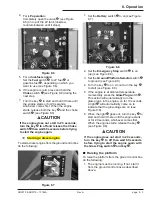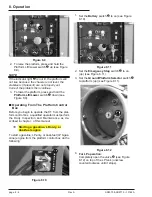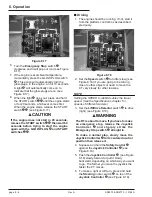
Figure 10.6
2. Set the
Battery
switch
~
(see Figure
10.6) to OFF and padlock it.
Figure 10.7
3.
(Option - LPG) For machines equipped
with LPG:
Close the valve
(see Figure 10.7) on the
LPG tank (completely screwed in).
Figure 10.8 - Tie-down Lugs
Al ways at tach chains to the front and back tie-down
lugs
(see Fig ures 10.8 and 10.9).
Figure 10.9 - Tie-down Lugs
Chocks may be re moved at this time, though it is a
good idea to leave them in place.
Re verse the above pro ce dure af ter trans port ing.
❑
Towing
Do not tow an
RT
. The
RT
hy drau lic-drive mo tors
will be per ma nently dam aged, and ren dered use -
less, by tow ing speeds.
❑
Lifting / Lashing Down
An
RT
can be safely lifted. How ever, only a trained
qual i fied ser vice tech ni cian should per form lift ing.
❑
Pushing
An
RT
can be safely pushed by hand on level, firm
sur faces. The pro ce dure for push ing is lo cated in
the Emer gency Op er a tion chap ter.
❑
Winching Procedure
1. Locate transport vehicle so that
RT
will not
roll forward after being loaded.
2. Fully lower platform and retract extension
deck.
3. Be sure the machine is centered with the
loading ramps and carrier vehicle bed, and
that the steering wheels are straight.
4. Attach the winch at the tie down lugs on the
front (steer) end of the chassis.
5. Disengage parking brakes and open
free-wheeling valve to prevent damage to
hydraulic motors. (Refer to procedures
outlined for pushing in the Emergency
Operation chapter 9.
6. Winch machine onto transport vehicle.
7. Close free-wheeling valve and reset parking
brakes.
SR3370 & SR2770 – 13184A
Rev A
page 10 - 3
10. Stowing and Transporting










































